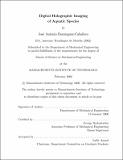| dc.contributor.advisor | George Barbastathis. | en_US |
| dc.contributor.author | Domínguez-Caballero, José Antonio | en_US |
| dc.contributor.other | Massachusetts Institute of Technology. Dept. of Mechanical Engineering. | en_US |
| dc.date.accessioned | 2007-08-29T18:38:51Z | |
| dc.date.available | 2007-08-29T18:38:51Z | |
| dc.date.copyright | 2006 | en_US |
| dc.date.issued | 2006 | en_US |
| dc.identifier.uri | http://hdl.handle.net/1721.1/35655 | |
| dc.description | Thesis (S.M.)--Massachusetts Institute of Technology, Dept. of Mechanical Engineering, 2006. | en_US |
| dc.description | This electronic version was submitted by the student author. The certified thesis is available in the Institute Archives and Special Collections. | en_US |
| dc.description | Includes bibliographical references (p. 160-174). | en_US |
| dc.description.abstract | The aim of this thesis is to design, develop and implement a digital holographic imaging (DHI) system, capable of capturing three-dimensional (3D) images of aquatic species. The images produced by this system are used in a non-intrusive manner to characterize the abundance, morphology and 3D location of the aquatic species. The DHI system operates by recording the hologram produced by the interference between a reference wave and the wave scatter by a coherently illuminated object with a charge-couple-device (CCD). The recorded hologram contains information about the amplitude and phase of the optical field as modified by the object. This optical field is retrieved by numerical algorithms, which enable the reconstruction of the field at different distances relative to the detector from a single hologram. The recording of the holograms with the CCD allows the implementation of image post-processing techniques intended to enhance the reconstructed images. A description of the optimization of the reconstruction by means of an auto-scan algorithm and the reconstruction of large holograms are discussed. It is found that the in-line single-beam experimental set-up is the most suitable configuration for underwater imaging of aquatic species. | en_US |
| dc.description.abstract | (cont.) This is experimentally verified by imaging brine shrimp and copepods under various conditions. Small, sub-10um features of the objects were successfully resolved. It is also found that by using configurations with a spherical reference wave, resolutions comparable to those obtained by a conventional optical microscope can be achieved in a "lens-free" approach with larger working distances. | en_US |
| dc.description.statementofresponsibility | by José Antonio Domínguez-Caballero. | en_US |
| dc.format.extent | 182 p. | en_US |
| dc.language.iso | eng | en_US |
| dc.publisher | Massachusetts Institute of Technology | en_US |
| dc.rights | M.I.T. theses are protected by copyright. They may be viewed from this source for any purpose, but reproduction or distribution in any format is prohibited without written permission. See provided URL for inquiries about permission. | en_US |
| dc.rights.uri | http://dspace.mit.edu/handle/1721.1/7582 | |
| dc.subject | Mechanical Engineering. | en_US |
| dc.title | Digital holographic imaging of aquatic species | en_US |
| dc.title.alternative | DHI of aquatic species | en_US |
| dc.type | Thesis | en_US |
| dc.description.degree | S.M. | en_US |
| dc.contributor.department | Massachusetts Institute of Technology. Department of Mechanical Engineering | en_US |
| dc.identifier.oclc | 76764566 | en_US |
